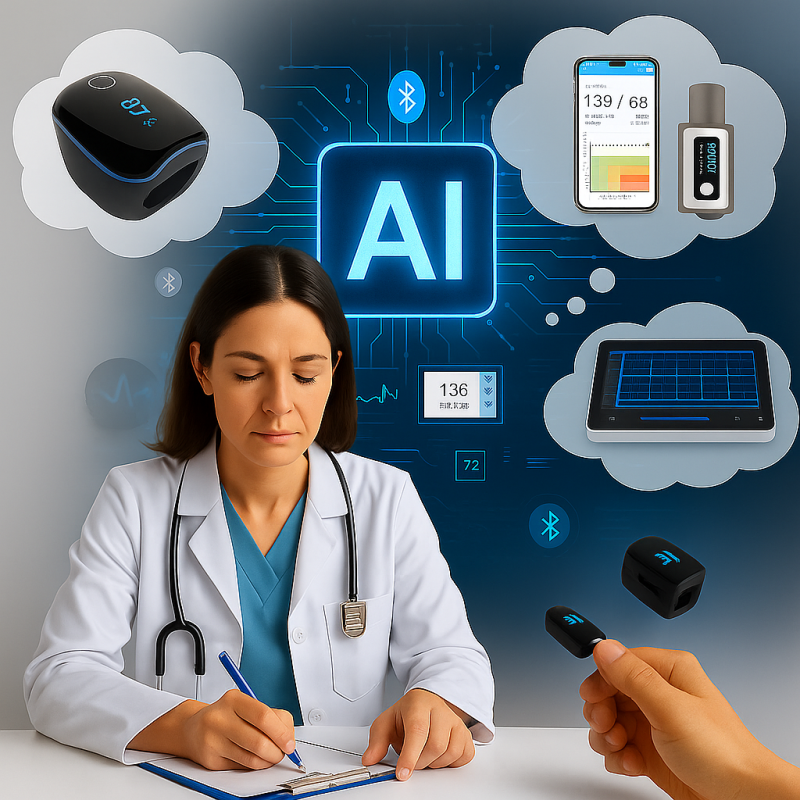Over the past few years, I’ve worked closely with general practitioners across South Africa, supplying ECGs, oximeters, and other diagnostic tools. And there’s one thing I keep seeing:
Despite all the medical technology available today, most GP workflows are still built around manual spot checks, printed ECGs, and handwritten notes.
It works — but it’s becoming increasingly outdated.
How Most GPs Handle Diagnostics Today
Here’s the typical setup in private practice:
-
Blood pressure is measured with a standalone cuff and written down manually.
-
SpO₂ is checked with a finger clip — often not recorded unless it’s abnormal.
-
ECG machines print reports, which are filed physically or scanned (if there’s time).
Each reading is taken in isolation, often with no long-term view. There’s no centralized record, no trend tracking, and no easy way to pull up previous data during follow-ups.
These tools seem affordable — and they are, upfront. But they’re often more time-consuming in the long run and lead to missed patterns and more admin.
The Hidden Cost of “Cheap” Devices
Basic diagnostic tools may seem like a smart buy — but they come with hidden costs:
-
No automatic report storage
-
No integration into patient records
-
Extra admin burden on staff
-
And most importantly, no holistic view of the patient’s health over time
Without context, readings can be misleading or incomplete. And that’s a missed opportunity for earlier, smarter intervention.
What If Everything Just… Talked to Each Other?
Now imagine this:
- A patient walks in. You take their ECG or blood pressure using a connected device — no printing, no handwritten notes. The data feeds directly into a secure, central portal.
- If they’ve used a home monitoring tool — like the O2 Ring overnight — their report is uploaded or automatically synced ahead of time.
- In one view, you see everything: trends over time, current readings, and relevant clinical flags. QTc risk, rising blood pressure patterns, or overnight oxygen drops are highlighted — whether captured in the clinic or at home.
You still make the call — but with full context, and no extra admin
This isn’t hypothetical. The devices already exist. What’s missing is the adoption and a platform that ties it all together.
We already offer devices like O2 Rings, Bluetooth BP monitors, and tablet ECG machines that form the building blocks of this vision.
The Workflow Advantage
This shift isn’t just about data — it’s about saving time and improving the way GPs work.
Right now, if a patient returns for a follow-up, the GP (or a staff member) has to:
-
Dig through a physical file to find their last BP or ECG printout
-
Hope it was filed correctly — and wasn’t misplaced or illegible
-
Try to recall or reconstruct trends from disconnected spot checks
It’s clunky, error-prone, and slow.
Now imagine instead:
-
No scanning of printed ECGs
-
No handwritten readings that go missing
-
No jumping between paper files and separate devices
Just clean, accessible diagnostics — stored securely, instantly retrievable, and ready when you need them.
In a busy practice, that’s not a luxury. It’s a necessity.
Enter AI: Quietly Changing the Diagnostic Landscape
Artificial intelligence isn’t here to replace GPs. But it is here to help:
-
Noticing slow QTc changes you wouldn’t catch with manual comparison
-
Spotting SpO₂ declines during sleep
-
Highlighting patients whose BP has crept upward over months
Think of it as a background assistant — not diagnosing, but surfacing the patterns that matter so you can act sooner.
In time, patients will expect this kind of precision. And those who adopt early will stand out — not just clinically, but commercially too.
So Why Hasn’t This Happened Yet?
There are a few reasons — and they go deeper than just awareness or hype.
1. The Tools Look the Same — But They’re Not
A R200 BP monitor and a R3,500 Bluetooth version both give you a number — but only one saves, syncs, and stores it. To most GPs, the difference doesn’t seem worth the price. What gets missed is the ability to track trends over time, reduce admin, and make smarter decisions with less effort.
2. Enterprise Systems Exist — But Aren’t Built for GPs
The only way to get real integration today is to buy into expensive enterprise systems, usually designed for hospitals. These come with high upfront costs and ongoing subscription fees — often well beyond what a small practice can afford. And even then, most of these systems don’t offer any meaningful AI support. They’re data warehouses, not diagnostic assistants.
3. GPs Are Time-Strapped and Under-Resourced
Most private practices run lean. There’s little time to manage multiple device apps, retrain staff, or overhaul workflows. If it’s not seamless, it doesn’t stick. And most connected tools today still feel like extra work, not less.
4. It Still Feels Like a ‘Nice-to-Have’
There’s no external pressure — from patients, funders, or regulation — to shift to smarter tools. So many GPs see connected diagnostics and AI support as optional. But that’s changing. As patients grow more tech-aware and AI becomes embedded in clinical tools, early adopters will have the edge — in outcomes, efficiency, and reputation.
Would You Use a System Like This?
If you’re a GP and this idea resonates — or if you’ve been frustrated by juggling disconnected diagnostics — I’d love to hear from you.
This isn’t just a concept. It’s something I’m actively exploring — based on real conversations with practices like yours.
Let’s build smarter, simpler diagnostics. Together.
